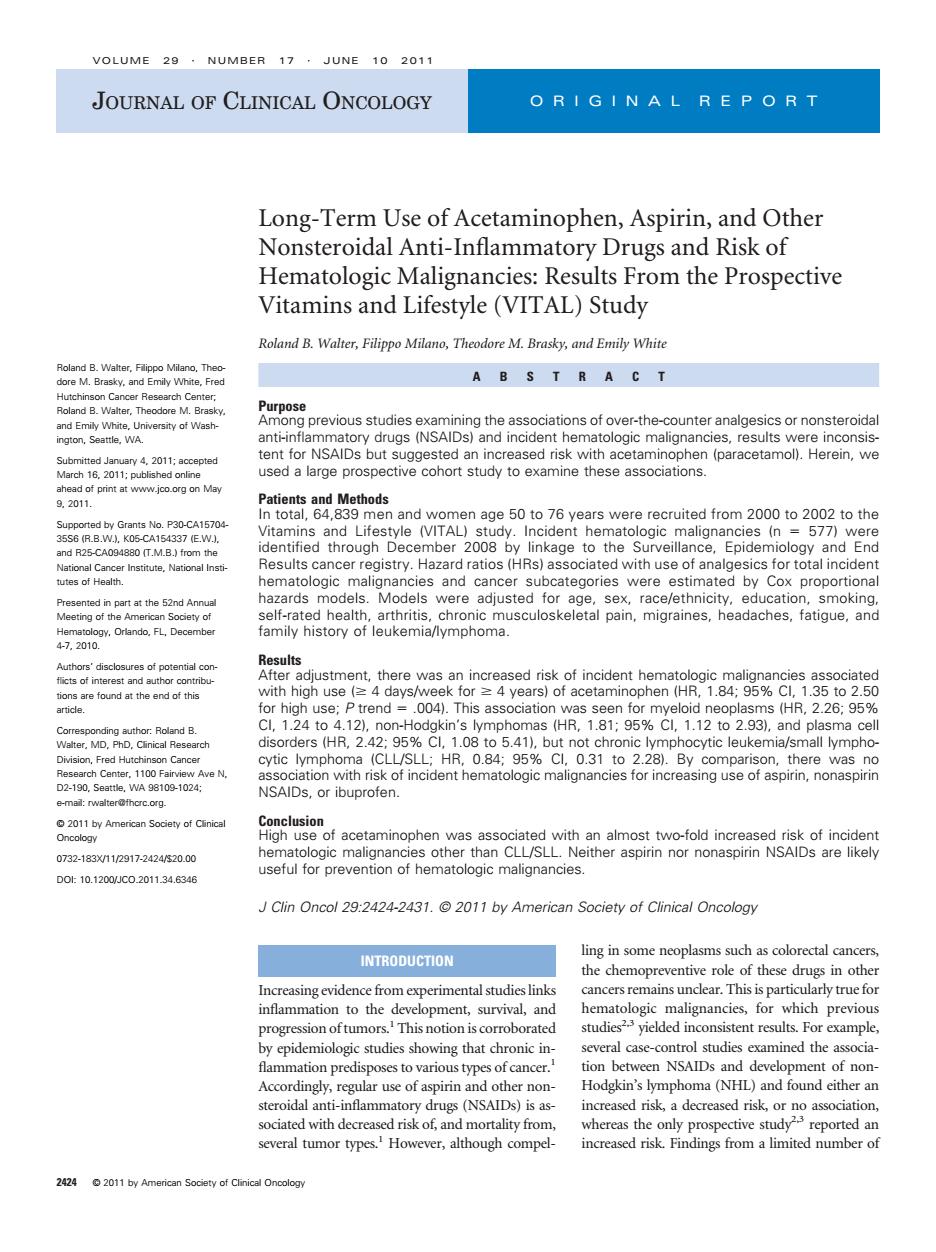正在加载图片...

VOLUME 29 NUMBER 17.JUNE 10 2011 JOURNAL OF CLINICAL ONCOLOGY Long-Term Use of Acetaminophen,Aspirin,and Other Nonsteroidal Anti-Inflammatory Drugs and Risk of Hematologic Malignancies:Results From the Prospective Vitamins and Lifestyle(VITAL)Study Roland B.Walter,Filippo Milano,Theodore M.Brasky,and Emily White A B S T R A C T r dn D inont o Herein,we men age 50 to 76 vears were recruited from 2000 to 2002 to the Inciden Results .Hazard ratios (HRs)edwithuse ofan ,racelethnle 42200 9gb98kamscmpaGnms6ulosteletalpgn.mganes.headeches,taigue.and 004 k to S(HR-22695 Cl,1.24 to .1)non-Hod kin's ho mas (HR.181:%Cl1.12 to 2.93).and plasma cel ers( HR 84g5%6C3 of incident hematologic malignancies for increasing use of aspirin,nonaspirir -10.s Soclueion fold in 8312172424s20C 0L10.120uc02013464 三gc兰NSAD3anha JClin Oncol 29:2424-2431.2011 by American Society of Clinical Oncology ling in some neoplasms such as colorectal cancer INTRODUCTION the chemopreventive role of these drugs in other Increasing evidence from experimental studieslinks cancers remains unear.This is particu arly true fo inflammation to the de es,for tion between NSAIDs and development of non- Accordingly,regular use of aspirin and other non Hodgkin's lymphoma(NHL)and found either an increased risk,a decreased Long-Term Use of Acetaminophen, Aspirin, and Other Nonsteroidal Anti-Inflammatory Drugs and Risk of Hematologic Malignancies: Results From the Prospective Vitamins and Lifestyle (VITAL) Study Roland B. Walter, Filippo Milano, Theodore M. Brasky, and Emily White Roland B. Walter, Filippo Milano, Theodore M. Brasky, and Emily White, Fred Hutchinson Cancer Research Center; Roland B. Walter, Theodore M. Brasky, and Emily White, University of Washington, Seattle, WA. Submitted January 4, 2011; accepted March 16, 2011; published online ahead of print at www.jco.org on May 9, 2011. Supported by Grants No. P30-CA15704- 35S6 (R.B.W.), K05-CA154337 (E.W.), and R25-CA094880 (T.M.B.) from the National Cancer Institute, National Institutes of Health. Presented in part at the 52nd Annual Meeting of the American Society of Hematology, Orlando, FL, December 4-7, 2010. Authors’ disclosures of potential con- flicts of interest and author contributions are found at the end of this article. Corresponding author: Roland B. Walter, MD, PhD, Clinical Research Division, Fred Hutchinson Cancer Research Center, 1100 Fairview Ave N, D2-190, Seattle, WA 98109-1024; e-mail: rwalter@fhcrc.org. © 2011 by American Society of Clinical Oncology 0732-183X/11/2917-2424/$20.00 DOI: 10.1200/JCO.2011.34.6346 ABSTRACT Purpose Among previous studies examining the associations of over-the-counter analgesics or nonsteroidal anti-inflammatory drugs (NSAIDs) and incident hematologic malignancies, results were inconsistent for NSAIDs but suggested an increased risk with acetaminophen (paracetamol). Herein, we used a large prospective cohort study to examine these associations. Patients and Methods In total, 64,839 men and women age 50 to 76 years were recruited from 2000 to 2002 to the Vitamins and Lifestyle (VITAL) study. Incident hematologic malignancies (n 577) were identified through December 2008 by linkage to the Surveillance, Epidemiology and End Results cancer registry. Hazard ratios (HRs) associated with use of analgesics for total incident hematologic malignancies and cancer subcategories were estimated by Cox proportional hazards models. Models were adjusted for age, sex, race/ethnicity, education, smoking, self-rated health, arthritis, chronic musculoskeletal pain, migraines, headaches, fatigue, and family history of leukemia/lymphoma. Results After adjustment, there was an increased risk of incident hematologic malignancies associated with high use ( 4 days/week for 4 years) of acetaminophen (HR, 1.84; 95% CI, 1.35 to 2.50 for high use; P trend .004). This association was seen for myeloid neoplasms (HR, 2.26; 95% CI, 1.24 to 4.12), non-Hodgkin’s lymphomas (HR, 1.81; 95% CI, 1.12 to 2.93), and plasma cell disorders (HR, 2.42; 95% CI, 1.08 to 5.41), but not chronic lymphocytic leukemia/small lymphocytic lymphoma (CLL/SLL; HR, 0.84; 95% CI, 0.31 to 2.28). By comparison, there was no association with risk of incident hematologic malignancies for increasing use of aspirin, nonaspirin NSAIDs, or ibuprofen. Conclusion High use of acetaminophen was associated with an almost two-fold increased risk of incident hematologic malignancies other than CLL/SLL. Neither aspirin nor nonaspirin NSAIDs are likely useful for prevention of hematologic malignancies. J Clin Oncol 29:2424-2431. © 2011 by American Society of Clinical Oncology INTRODUCTION Increasing evidence from experimental studies links inflammation to the development, survival, and progression of tumors.1 This notion is corroborated by epidemiologic studies showing that chronic in- flammation predisposes to various types of cancer.1 Accordingly, regular use of aspirin and other nonsteroidal anti-inflammatory drugs (NSAIDs) is associated with decreased risk of, and mortality from, several tumor types.1 However, although compelling in some neoplasms such as colorectal cancers, the chemopreventive role of these drugs in other cancers remains unclear. This is particularly true for hematologic malignancies, for which previous studies2,3 yielded inconsistent results. For example, several case-control studies examined the association between NSAIDs and development of nonHodgkin’s lymphoma (NHL) and found either an increased risk, a decreased risk, or no association, whereas the only prospective study2,3 reported an increased risk. Findings from a limited number of JOURNAL OF CLINICAL ONCOLOGY ORIGINAL REPORT VOLUME 29 NUMBER 17 JUNE 10 2011 2424 © 2011 by American Society of Clinical Oncology